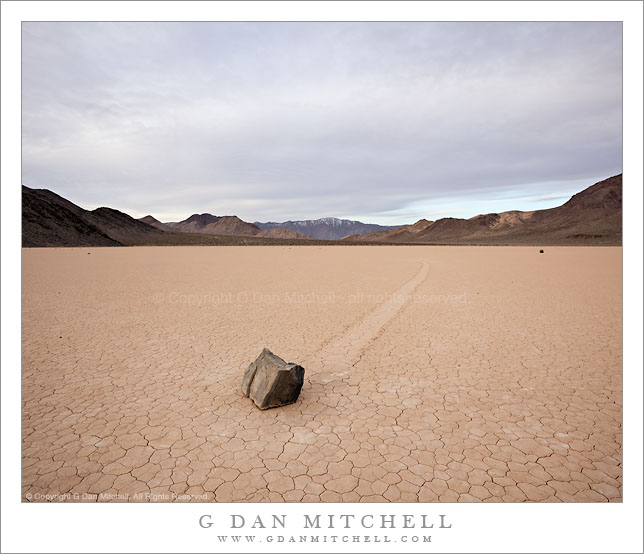Moving Rock, Overcast Morning Sky – Racetrack Playa. Death Valley National Park, California. March 29, 2010. © Copyright G Dan Mitchell – all rights reserved.
A “moving rock” beneath overcast morning skies at the Racetrack Playa, Death Valley.
First a bit of background about “the Racetrack,” the location of the famous “moving rocks” in Death Valley National Park. About 25 miles out in the desert back-country of the park on a very bad gravel road there is an isolated and desolate playa known as “the Racetrack.” (For those considering a visit, getting to the Racetrack is no trivial matter. The drive takes nearly two hours one-way and the road is awful, with some of the worst wash-board surface I’ve ever encountered. There are absolutely no services along the road or at the Racetrack – no water is available and your cell phone won’t work.) The name of the place comes, in some circuitous way, from the mysterious rocks that have clearly traveled across the playa, sometimes many hundreds of yards, and left tracks gouged into the playa surface. The most likely explanation for the phenomenon involves a combination of a periodically flooded playa, extremely high winds, and rare occasions when it is cold enough to freeze the surface of collected water, locking the rocks in place and allowing the wind to move them. I’ve never heard anything concrete about the frequency of this alignment of conditions, but as far as I know no one has ever observed the rocks actually moving, nor is there any indication that they have moved recently.
I’ve been out there three times in the past, and had great conditions for doing photography. On this visit I had plans to photograph in sunset and sunrise light and to attempt night photography of the rocks under the full moon. (I did the latter once before, but was less familiar than I am now with how to best do this with a DSLR.) Since I’ve had such good luck with weather and lighting conditions in the past, I suppose I was due for less than optimum conditions… and that is what I encountered. Shortly after arriving at the playa the sky was covered by high, thin clouds. Except for a brief moment close to sunset this made late day photography difficult. The overcast stuck around until I left then next morning, making the planned full moon night photography an impossibility, and the morning light was also challenging.
That said, I’m still glad I went. Standing in the middle of this empty playa completely alone as the day ends or begins is an amazing experience that few people get to have. And I did manage to bring back a few photographs that I think will “work.” This one was shot fairly early in the morning at what might have been around sunrise, if a sunrise had actually occurred.
This photograph is not in the public domain and may not be used on websites, blogs, or in other media without advance permission from G Dan Mitchell.
G Dan Mitchell Photography | Twitter | Friendfeed | Facebook | Facebook Fan Page | Email
Technical Data:
Canon EOS 5D Mark II
Canon EF 17-40mm f/4 L at 17mm
ISO 200, f/16, 1/8 second
keywords: moving, sliding, rock, race, track, racetrack, playa, death valley, national, park, california, usa, north america, morning, cloudy, sky, earth, cracked, dry, arid, desert, mountain, snow, covered, inyo, landscape, nature, travel, scenic, mystery, track, trail, phenomenon, lippencott, mine, road, stock


